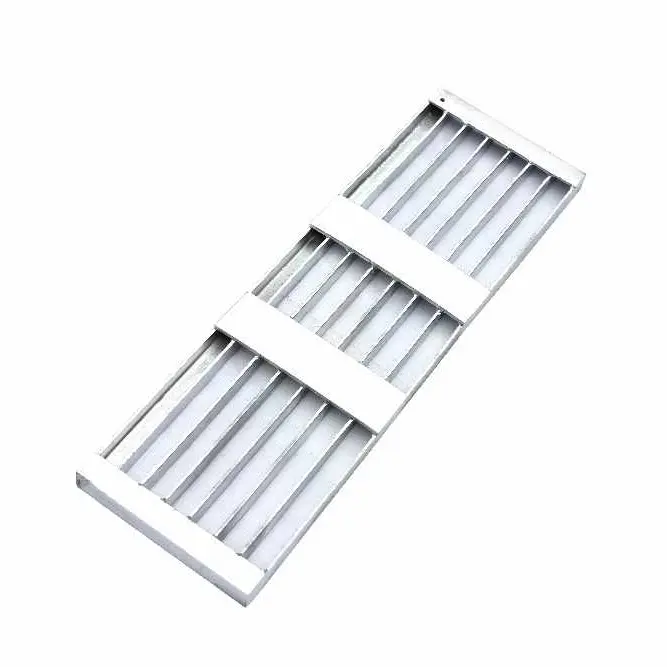Walkway steel grating is an essential component in industrial facilities, infrastructure projects, and commercial construction where safe, durable, and efficient access pathways are required. As factories, energy plants, and public facilities continue to expand globally, the demand for high-performance walkway grating is increasing steadily. With its high strength, ventilation capability, and anti-slip performance, walkway steel grating plays a key role in ensuring personnel safety and long-term structural stability.
This article provides an in-depth analysis of walkway steel grating from the perspectives of material structure, engineering advantages, application scenarios, and product characteristics to help B2B buyers understand its importance in industrial flooring systems.
What Is Walkway Steel Grating?
Walkway steel grating is an open-grid flooring system composed of welded or press-locked steel bars, specifically designed for heavy loading and continuous-use environments. It offers safe and stable walking surfaces widely used on elevated platforms, equipment zones, production lines, drainage areas, and maintenance walkways. Its open-grid construction provides ventilation, drainage, and visibility—essential features for industrial settings where airflow and operational safety are priorities.
The product is generally manufactured from carbon steel, galvanized steel, or stainless steel. Each material delivers different levels of strength, corrosion resistance, weight, and maintenance requirements depending on the installation environment.
Structural Features and Material Performance
The performance of walkway steel grating comes from its engineered structural design. With the combination of bearing bars and cross bars, the grating forms a rigid and highly durable platform suitable for supporting personnel, equipment, and rolling loads in demanding industrial environments.
• High-strength bearing bars provide stable support across wide spans
• Welded or press-locked cross bars increase rigidity
• Hot-dip galvanized surface enhances long-term corrosion resistance
• Anti-slip surface options improve worker safety in wet or oily environments
• Open-grid design supports ventilation, drainage, and heat dissipation
• High load ratings suitable for petrochemical, mining, marine, and heavy industrial applications
These structural and material properties ensure walkway steel grating remains safe, stable, and durable under continuous operational pressure.
Application Scenarios in Industrial and Commercial Facilities
Due to its versatility, strength, and high safety performance, walkway steel grating is widely used across various industrial and commercial sectors. Its capability to withstand heavy loads and harsh conditions makes it suitable for:
• Maintenance walkways in factories, workshops, and machinery areas
• Oil and gas platforms, petrochemical plants, and refinery structures
• Power plants, boiler rooms, and turbine maintenance platforms
• Sewage treatment plants and water facility access bridges
• Ship decks, port terminals, and offshore platforms
• Mining sites and heavy industrial processing areas
• Elevated pedestrian walkways, stair treads, and catwalk systems
These applications highlight the importance of walkway grating in high-risk and heavy-duty environments.
Product Structure and Design Advantages
To ensure safe and long-term performance in industrial environments, walkway steel grating incorporates several engineered structural enhancements. These design features increase its durability, safety, and adaptability.
• Reinforced welding points enhance mechanical stability
• Multiple bearing bar configurations (serrated, plain, I-bar) adapt to different working environments
• Customizable load-bearing levels to meet specific safety requirements
• Compatible with frame mounting, bolt fixing, and clip installation systems
• Lighter than solid steel plates, reducing structural load
• High open-area ratio improves ventilation and reduces debris accumulation
• Fire-resistant properties make it suitable for high-temperature industrial zones
These design benefits make walkway steel grating a reliable choice in facilities requiring high operational safety and structural integrity.
Manufacturing Processes and Quality Control
High-quality walkway steel grating relies on precise manufacturing techniques to ensure uniform spacing, secure welding, and dimensional accuracy. Professional manufacturers typically follow strict quality-control procedures:
• CNC cutting for accurate sizing of bearing bars
• Automated welding ensures uniform strength across the grating
• Press-locked manufacturing enhances structural rigidity
• Hot-dip galvanizing provides full-surface corrosion protection
• Surface inspections eliminate sharp edges and ensure personnel safety
• Load and deflection testing validate performance under specified conditions
• Dimensional accuracy checks ensure smooth installation on project sites
These manufacturing processes guarantee stable product quality for large-scale engineering projects.
Advantages of Walkway Steel Grating in Modern Industrial Environments
Walkway steel grating is preferred by engineering contractors, EPC firms, and facility managers due to its mechanical strength and operational efficiency. Major advantages include:
• High structural strength to support frequent foot traffic and heavy-duty operations
• Anti-slip and open-grid design improving worker safety
• Corrosion-resistant coatings reduce maintenance costs
• Easy installation suitable for new construction and retrofit projects
• Enhanced ventilation for enclosed or high-temperature environments
• Lower overall weight reduces construction and support structure costs
• Long service life with minimal replacement requirements
These advantages make walkway steel grating a cost-effective and dependable flooring system for modern industrial environments.
Summary
Walkway steel grating is an indispensable component of industrial and commercial infrastructure. With high load capacity, corrosion resistance, and anti-slip performance, it ensures long-term safety and reliability in walkways, platforms, catwalks, and access areas. For B2B customers, selecting high-quality walkway grating not only improves structural safety but also reduces maintenance costs and enhances overall operational stability. As industrial projects continue to evolve, walkway steel grating will play an increasingly important role in creating safe and efficient working environments.
FAQ
What materials are commonly used for walkway steel grating?
Carbon steel, galvanized steel, and stainless steel are the most common options selected according to load needs and environmental conditions.
Is walkway steel grating suitable for outdoor or corrosive environments?
Yes. Hot-dip galvanized and stainless-steel grating offer excellent corrosion resistance for outdoor, marine, and chemical exposure environments.
Can walkway steel grating be customized?
Yes. Customization is available for bar spacing, serration type, load capacity, dimensions, and installation hardware.
Where is walkway steel grating typically installed?
It is commonly used in factories, power plants, water-treatment facilities, oil platforms, mining operations, elevated walkways, and catwalk systems.
Post time: Nov-25-2025

